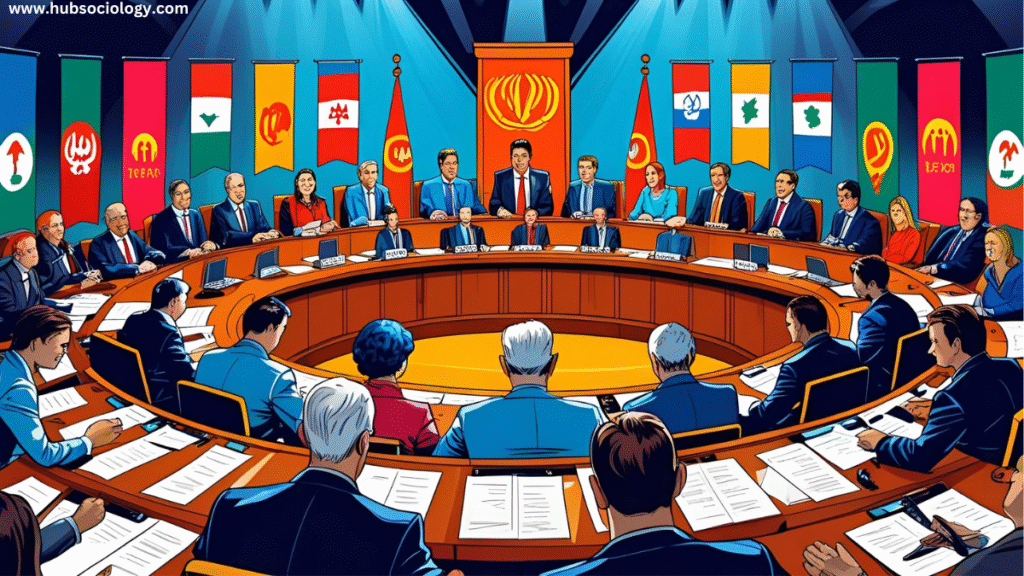Introduction
The study of global development has long been shaped by competing theories that attempt to explain why some nations prosper while others remain economically and politically marginalized. Among these, World System Theory—pioneered by sociologist Immanuel Wallerstein in the 1970s—offers one of the most influential frameworks for understanding global inequality. Unlike modernization theory, which assumes that all nations can follow the same path toward development, or dependency theory, which emphasizes exploitation by the developed world, world system theory views development as part of a global capitalist system that inherently creates and maintains inequality.
This World System Theory reveals that development and underdevelopment are not separate phenomena but two sides of the same global process.
The Origins of World System Theory
World System Theory emerged as a response to the shortcomings of modernization and dependency theories during the Cold War era. Wallerstein, drawing upon the works of Karl Marx, Fernand Braudel, and Andre Gunder Frank, sought to create a comprehensive historical-sociological model that could explain global capitalism’s rise and its continuing impact. He proposed that the modern world system began in the 16th century, when European powers expanded through colonialism, trade, and industrialization—creating a global network of economic and political relationships.

For Wallerstein, the modern capitalist world system is not merely a collection of individual nation-states but a single social system integrated through an international division of labor. This division of labor determines how wealth and resources flow across the globe, shaping the destiny of entire societies.
Core Concepts of World System Theory
Wallerstein divided the global system into three interrelated zones—the core, semi-periphery, and periphery. Each zone has distinct roles within the international capitalist economy.
1. Core Countries
Core nations are the economically dominant, technologically advanced, and politically powerful states that control global trade and finance. These include historically industrialized nations such as the United States, Japan, Germany, and Western European countries. Core countries specialize in capital-intensive, high-profit production and maintain dominance by exploiting labor and resources from peripheral countries.
2. Peripheral Countries
Peripheral countries are the least developed and most dependent regions of the world system. They are primarily producers of raw materials, agricultural products, and cheap labor. These nations—mostly in Africa, Latin America, and parts of Asia—are integrated into the global economy in ways that serve the interests of the core. Their economies are characterized by inequality, limited industrialization, and weak state institutions. In sociological terms, peripheries experience structural underdevelopment, not because they have failed to modernize, but because they are systematically exploited.
3. Semi-Peripheral Countries
Semi-peripheral nations occupy a middle position between the core and periphery. Examples include countries such as India, Brazil, China, and South Africa. These nations often serve as buffers within the world system—exploiting the periphery while being dependent on the core. The semi-periphery is crucial because it provides political stability to the system, preventing direct polarization between the core and periphery.
The Capitalist World Economy
At the heart of world system theory lies the concept of the capitalist world economy. Wallerstein argued that capitalism is not confined to national boundaries—it is a world economy characterized by the pursuit of profit, market expansion, and unequal exchange. This system operates on the basis of continuous accumulation of capital, achieved through global labor exploitation and resource extraction.

In sociological terms, the capitalist world economy creates global class structures. The bourgeoisie of the core countries benefit from cheap labor and resources from peripheral societies, while workers in peripheral regions face poverty and economic insecurity. Thus, global capitalism mirrors and magnifies class relations on a worldwide scale.
Development and Underdevelopment: A Relational Process
One of the most significant sociological contributions of world system theory is its relational understanding of development. According to Wallerstein, development in the core and underdevelopment in the periphery are not independent processes—they are mutually constitutive. The economic prosperity of the core depends on the continued exploitation of peripheral societies.
For instance, colonialism in Africa and Asia extracted wealth and labor to fuel industrialization in Europe. Even after formal decolonization, mechanisms such as trade dependency, foreign investment, debt, and multinational corporations maintained the same unequal relations. In this sense, global inequality is not accidental—it is structurally built into the capitalist world system.
World System Theory and Globalization
In the late 20th and early 21st centuries, globalization has intensified the dynamics described by world system theory. The spread of transnational corporations, global supply chains, and digital capitalism has reinforced the global division of labor. While some argue that globalization promotes shared prosperity, Wallerstein’s perspective suggests that it deepens the dependence of the periphery on the core.
Globalization also produces new forms of inequality—such as digital divides, ecological degradation, and migrant labor exploitation. For example, electronic products designed in the core are often manufactured in semi-peripheral countries like China using resources extracted from peripheral regions like Africa. This process reflects the unequal exchange and asymmetrical integration central to world system analysis.
Critiques of World System Theory
While world system theory remains highly influential, it has faced several criticisms from sociologists and political economists:
- Eurocentrism – Critics argue that Wallerstein’s model is overly Eurocentric, focusing primarily on Europe’s role in shaping the world system and underestimating the contributions of non-Western civilizations.
- Economic Determinism – Some sociologists believe that the theory overemphasizes economic factors and neglects cultural, political, and ideological dimensions of development.
- State Agency – By focusing on structural forces, world system theory tends to overlook the agency of nation-states and social movements that can challenge the system.
- Static Categorization – The tripartite division (core, semi-periphery, periphery) may oversimplify the complexities of modern global interactions, especially in an era of digital economies and shifting alliances.
Despite these critiques, the theory’s strength lies in its macro-sociological perspective, revealing how global inequalities persist through historical and systemic mechanisms.
Relevance in Contemporary Development Sociology
In today’s world of neoliberal globalization, debt crises, and environmental challenges, world system theory continues to offer vital insights. For sociologists studying development, it helps explain why poverty and inequality persist despite decades of aid and modernization efforts. It also sheds light on how transnational institutions—like the IMF, World Bank, and WTO—reproduce global hierarchies by enforcing policies that benefit core economies.

Furthermore, world system analysis has inspired new approaches such as world-systems feminism and ecological world systems theory, which examine how gender relations and environmental exploitation are embedded in the capitalist world order. For instance, feminist scholars highlight how women’s unpaid labor and migration are central to global production chains, while environmental sociologists emphasize how ecological degradation disproportionately affects peripheral nations.
Conclusion
From a sociological standpoint, World System Theory offers a profound and enduring framework for understanding development as part of a global social structure shaped by capitalism, colonialism, and inequality. It challenges the myth that development is a linear, national process and instead situates it within the dynamics of a world economy that connects all societies in asymmetrical ways.
In essence, the theory reveals that underdevelopment is not a sign of failure but a consequence of the global system itself. As the world faces widening inequality, climate change, and geopolitical tensions, Wallerstein’s analysis remains crucial for comprehending how power, wealth, and development continue to be unequally distributed across the globe. For sociologists, this perspective underscores that true development requires not just economic growth, but a transformation of the global structures that sustain inequality.
Do you like this this Article ? You Can follow as on :-
Facebook – https://www.facebook.com/hubsociology
Whatsapp Channel – https://whatsapp.com/channel/0029Vb6D8vGKWEKpJpu5QP0O
Gmail – hubsociology@gmail.com
Topic Related Questions
5 Marks Questions (Short Answer Type)
- Who is the founder of World System Theory?
- What are the three main categories of nations in Wallerstein’s world system?
- Define the term “core countries” in World System Theory.
- What is meant by the term “peripheral countries”?
- In which century did the modern world system begin according to Wallerstein?
- What is the main focus of World System Theory?
- Name two key differences between modernization theory and world system theory.
- What role do semi-peripheral countries play in the global system?
- Mention one major criticism of World System Theory.
- How does World System Theory view development and underdevelopment?
10 Marks Questions (Medium Answer Type)
- Discuss the main features of Immanuel Wallerstein’s World System Theory.
- Explain how World System Theory differs from dependency theory.
- Analyze the role of core, semi-periphery, and periphery in the world capitalist system.
- How does World System Theory explain the persistence of global inequality?
- Evaluate the relevance of World System Theory in understanding globalization.
- What are the major criticisms of Wallerstein’s World System Theory?
- Explain how capitalism functions as a world economy according to Wallerstein.
- How does World System Theory interpret the relationship between development and underdevelopment?
- Discuss the sociological significance of the international division of labor in the world system.
- Examine the impact of World System Theory on the study of development sociology.
15 Marks Questions (Long Answer / Essay Type)
- Critically examine the World System Theory of Immanuel Wallerstein as an approach to global development.
- Discuss in detail the emergence, structure, and dynamics of the capitalist world economy as explained by Wallerstein.
- “Development and underdevelopment are two sides of the same coin.” — Explain this statement with reference to World System Theory.
- Analyze the sociological relevance of World System Theory in the contemporary globalized world.
- Evaluate the contributions and limitations of World System Theory in explaining global inequality and development.
- Compare and contrast modernization theory, dependency theory, and world system theory in explaining development.
- How does World System Theory help in understanding the unequal relationship between developed and developing nations?
- Discuss the historical origins and evolution of the modern world system since the 16th century.
- Examine the sociological implications of the core–periphery structure for global labor, trade, and politics.
- “World System Theory provides a macro-sociological framework for analyzing development.” — Discuss with examples.
